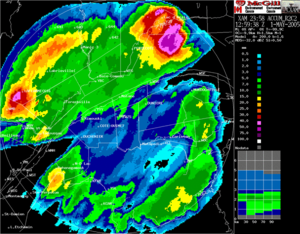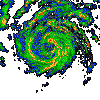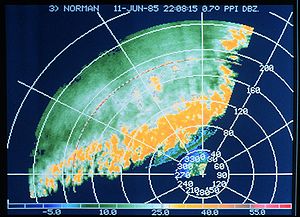Error Data in Weather Radar
In the sky there is more than rain and snow. Other objects can be misinterpreted as rain by a weather radar. The main ones are[10]:
* Birds, especially in period of migration.
* Insects at low altitude.
* Thin metal strips (chaff) dropped by military aircraft to fool enemies.
* Solid obstacles such as mountains, buildings, and aircraft.
* Ground and sea clutter.
* Reflections from buildings if the radar is close enough to a city (called urban spikes).
Each of them has their own characteristics that make it possible to distinguish them to the trained eye but they may fool a layman. It is possible to eliminate some of them with post-treatment of data using reflectivity, Doppler, and polarization data.
Wednesday, October 15, 2008 | 0 Comments
Type Data Output from weather Radar : others
Accumulations One of the main use of radar is to be able to assess the amount of precipitations fallen over large basins for hydrological purpose. For instance, river flood control, sewer management and dam construction are all areas where planners want accumulation data. It ideally completes surface stations data which they can use for calibration.
One of the main use of radar is to be able to assess the amount of precipitations fallen over large basins for hydrological purpose. For instance, river flood control, sewer management and dam construction are all areas where planners want accumulation data. It ideally completes surface stations data which they can use for calibration.
To produce radar accumulations, we have to estimate the rain rate over a point by the average value over that point between one PPI, or CAPPI, and the next; then multiply by the time between those images. If one wants for a longer period of time, one has to add up all the accumulations from images during that time.
Echotops
Aviation is a heavy user of radar data. One map particularly important in this field is the Echotops for flight planning and avoidance of dangerous weather. Most country weather radars are scanning enough angles to have a 3D set of data over the area of coverage. It is relatively easy to estimate the maximum altitude at which precipitation is found within the volume. However, those are not the tops of clouds as they extended to higher altitudes than the precipitation.
Vertical cross sections
To know the vertical structure of clouds, in particular thunderstorms or the level of the melting layer, a vertical cross sections product of the radar data is available to meteorologist. This is done by displaying only the data along a line, from coordinates A to B, taken from the different angles scanned.
Range Height Indicator
When a weather radar is scanning in only one direction vertically, it obtains high resolution data along a vertical cut of the atmosphere. The output of this sounding is called a Range Height Indicator (RHI) which is excellent for viewing the detailed vertical structure of a storm. This is different from the vertical cross section mentioned above by the fact that the radar is making a vertical cut along specific directions and does not scan over the entire 360 degrees around the site. This kind of sounding and product is only available on research radars.
Radar networks
Over the past few decades, radar networks have been extended to allow the production of composite views covering large areas. For instance, all major countries (e.g., the United States, Canada, much of Europe) produce images that include all of their radars. This is not as trivial a task.
In fact, such a network can consist of different types of radar with different characteristics like beam width, wavelength and calibration. These differences have to be taken into account when matching data across the network, particularly to decide what data to use when two radars cover the same point. If one uses the stronger echo but it comes from the most distant radar, one uses returns that are from higher altitude coming from rain or snow that might evaporate before reaching the ground (virga). If one uses data from the closest radar, it might be attenuated passing through a thunderstorm. Composite images of precipitations using a network of radars are made with all those limitations in mind.
Wednesday, October 15, 2008 | 0 Comments
Type Data Output from Weather Radar : Animation
 The animation of radar products can show the evolution of reflectivity and velocity patterns. The user can extract information on the dynamics of the meteorological phenomena, including the ability to extrapolate the motion and observe development or dissipation. This can also reveal non-meteorological artifacts (false echoes) that will be discussed later.
The animation of radar products can show the evolution of reflectivity and velocity patterns. The user can extract information on the dynamics of the meteorological phenomena, including the ability to extrapolate the motion and observe development or dissipation. This can also reveal non-meteorological artifacts (false echoes) that will be discussed later.
Wednesday, October 15, 2008 | 0 Comments
Type Data Output from Weather Radar : VIL
VERTICAL INTEGRATED LIQUID Automatic algorithmsTo help meteorologists to spot dangerous weather, mathematical algorithms have been introduced in the weather radar treatment programs. These are particularly important in the analyzing the Doppler velocity data as they are more complex. The polarization data will even need more algorithms.
Automatic algorithmsTo help meteorologists to spot dangerous weather, mathematical algorithms have been introduced in the weather radar treatment programs. These are particularly important in the analyzing the Doppler velocity data as they are more complex. The polarization data will even need more algorithms.
Main algorithms for reflectivity[7]:
* Vertically Integrated Liquid (VIL) is an estimate of the total mass of precipitation in the clouds.
* Potential wind gust, which can estimate the winds under a cloud (a downdraft) using the VIL and the height of the echotops (radar estimated top of the cloud) for a given storm cell.
* Hail algorithm that estimates the presence and potential size.
Main algorithms for Doppler velocities[7]:
* Mesocyclone detection: it is triggered by a velocity change over a small circular area. The algorithm is searching for a "doublet" of inbound/outbound velocities with the zero line of velocities, between the two, along a radial line from the radar. Usually the mesocyclone detection must be found on two or more stacked progressive tilts of the beam to be significative of rotation into a thunderstom cloud.
* TVS or Tornado Vortex Signature algorithm is essentially a mesocyclone with a large velocity threshold found through many scanning angles. This algorithm is used in NEXRAD to indicate the possibility of a tornado formation.
* Wind shear in low levels. This algorithm detects variation of wind velocities from point to point in the data and looking for a doublet of inbound/outbound velocities with the zero line perpendicular to the radar beam. The wind shear is associated with downdraft, (downburst and microburst), gust fronts and turbulence under thunderstorms.
* VAD Wind Profile (VWP) is a display that estimates the direction and speed of the horizontal wind at various upper levels of the atmosphere, using the technique explained in the Doppler section.
Wednesday, October 15, 2008 | 0 Comments
Type Data Output fro Weather Radar : VC
Vertical composite
Another solution to the PPI problems is to produce images of the maximum reflectivity in a layer above ground. This solution is usually taken when the number of angles available is small or variable. The American National Weather Service is using such Composite as their scanning scheme can vary from 4 to 14 angles, according to their need, which would make very coarse CAPPIs. The Composite make sure that no strong echo is missed in the layer and a treatment using Doppler velocities eliminate the ground echoes. Comparing base and composite products, one can locate virga and updrafts zones.Wednesday, October 15, 2008 | 0 Comments
Type Data Output from Weather Radar : CAPPI
Constant Altitude Plan Position Indicator
To avoid some of the problems on PPIs, the CAPPI or Constant Altitude Plan Position Indicator has been developed by researchers in Canada. It is basically a horizontal cross-section through radar data. This way, one can compare precipitation on an equal footing at difference distance from the radar and avoid ground echoes. Although data are taken at a certain height above ground, a relation can be inferred between ground stations reports and the radar data.CAPPIs call for a large number of angles from near the horizontal to near the vertical of the radar in order to have a cut that is as close as possible at all distance to the height needed. But even then, after a certain distance, there isn’t any angle available and the CAPPI becomes the PPI of the lowest angle. The zigzag line on the angles diagram above shows the data used to produce a 1.5 and 4 km height CAPPIs. Notice that the section after 120 km is using the same data.
USAGE: Mostly for reflectivity data. McGill University is producing Doppler CAPPIs but the nature of velocity make the output a bit noisy as velocities can change rapidly in direction with height contrary to a relatively smooth pattern in reflectivity.
Wednesday, October 15, 2008 | 0 Comments
Type Data Output from Weather Radar : PPI
Plan position indicator
 Since data are obtained one angle at a time, the first way of displaying them as been the Plan Position Indicator (PPI) which is only the layout of radar return on a two dimensional image. One has to remember that the data coming from different distances to the radar are at different heights above ground.
Since data are obtained one angle at a time, the first way of displaying them as been the Plan Position Indicator (PPI) which is only the layout of radar return on a two dimensional image. One has to remember that the data coming from different distances to the radar are at different heights above ground.This is very important as a high rain rate seen near the radar is relatively close to what reach the ground but what is seen from 160 km (100 miles) away is about 1.5 km above ground and could be far different from the amount reaching the surface. It is thus difficult to compare weather echoes at different distance from the radar.
PPIs are afflicted with ground echoes near the radar as a supplemental problem. These can be misinterpreted as real echoes. So other products and further treatments of data have been developed to supplement its shortcomings.
USAGE: Reflectivity, Doppler and polarimetric data can use PPI.
N.B.: In the case of Doppler data, two points of view are possible: relative to the surface or the storm. When looking at the general motion of the rain to extract wind at different altitudes, it is better to use data relative to the radar. But when looking for rotation or wind shear under a thunderstorm, it is better to use the storm relative images that subtract the general motion of precipitation leaving the user to view the air motion as if he would be sitting on the cloud.
Wednesday, October 15, 2008 | 0 Comments
